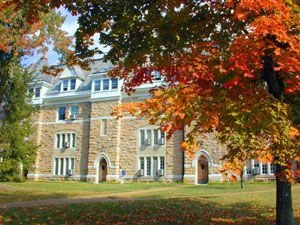
University of the South
In 1857, when it was learned that the dioceses of the Episcopal Church planned to establish an educational center, citizens of Franklin County made common cause with the Sewanee Mining Company to offer a 10,000-acre parcel, half of which was carved from the 140,000 acres given to the company by the State of Tennessee for the industrial development of the coal-bearing lands of the plateau. The Sewanee site, which met the required altitude of eighteen hundred feet, placed the proposed center above the malaria line and was made more attractive by the addition of a nine-mile railroad that climbed the mountain and cut across the university domain.
The plans for the center called for thirty schools or colleges offering a full range of classics and such practical subjects as agriculture and forestry. In the 1850s the wealth of southern Episcopalians and the tradition of an educated clergy made such an imaginative project seem feasible. Bishops James Hervey Otey of Tennessee and Stephen Elliott of Georgia joined with Louisiana Bishop Leonidas Polk to provide the leadership for the project. Polk and Elliott raised the largest sum ever pledged for an educational institution in America from the Louisiana diocese alone.
In 1860 the cornerstone was laid in an elaborate ceremony attended by eight bishops and several thousand people. The intervention of the Civil War disrupted plans for the university and almost destroyed the idea. By 1866 all three of the original founders were dead, the cornerstone had been blown apart, and the forest had reclaimed the clearing. When Bishop Charles T. Quintard made a quick trip through the South to raise funds to begin anew, he did not net enough to pay his expenses despite the fact that he traveled on a railroad pass.
Then Quintard’s brother donated funds to allow the bishop to attend the first Lambeth Conference of Anglican bishops in England. While there, the bishop preached 250 sermons in 180 days and raised 2,500 British pounds to reopen the university. With only a week to spare before the deed to the property expired, the doors of a clapboard “chapel” opened to admit nine students and four professors. Quintard and Bishop William M. Green of Mississippi donned their ecclesiastical finery, and the tiny procession formally established the University of the South on September 18, 1868.
The poverty that characterized the South in this period produced one blessing. The institution could bring to its faculty a quality of teaching normally unavailable to a struggling college. Brigadier General Josiah Gorgas came to head the junior department and teach the sciences. Robert Dabney of Virginia taught literature. Confederate General Edmund Kirby Smith taught math. Thus was the standard of excellence set that has been the hallmark of the college. As the century closed, the University of the South, with an enrollment of over three hundred students, offered coursework in the classics, theology, medicine, law, and engineering. Even the football team was impressive, remaining undefeated in 1898 and 1899.
Beginning in 1909, financial problems almost closed the school, and enrollment fell to one hundred students. The school continued to function through the persistence of a few teachers who worked without knowing when or if they would be paid. A military unit kept classes going during World War I. Despite these setbacks, the institution survived and continued through the years of the Great Depression. In 1938 Alexander Guerry assumed leadership of the university and returned it to full enrollment and sound fiscal condition. In the 1950s vice-Chancellor Edward McCrady oversaw a substantial building program that included new housing for faculty and students, a new library, and a science hall.
Today, enrollment at the university remains steady, the endowment has reached $200 million (among the highest per student in the nation), and the school enjoys a national academic reputation. The School of Theology, which awards several doctoral degrees annually, has moved to the Sewanee Academy campus, vacated in 1981 when that institution merged with nearby St. Andrew’s School. Several new programs and buildings are on the drawing board, including a theatre complex to be built using funds bequeathed by dramatist Tennessee Williams in honor of his grandfather, the Reverend Walter E. Dakin, a theological student at the university in the 1890s. The Dakin Fund also sponsors programs in creative writing.
The Sewanee Review, the oldest literary-critical quarterly in America, celebrated its one-hundredth anniversary in 1992, and the Order of Gownsmen, a student governing body unique among student organizations in this country, is now nearly 130 years old. The university has hosted the Sewanee Summer Music Festival for over forty years. In the 1960s the university began admitting women students, something that previously had been permitted only in summer school. University of the South athletes compete in NCAA Division III and are awarded scholarships on the basis of financial need, with a few honor scholarships.
The university maintains its original hallmarks–ownership by the Episcopal Church, regard for the classics, a fondness for the traditions of the English universities. Though the military tradition is no longer a part of campus life, the University of the South has developed an international character as the enrollment of foreign students increases, and programs for study abroad are made available to a growing number of students.
Suggested Reading
Arthur B. Chitty Jr., Reconstruction at Sewanee: The Founding of the University of the South and Its First Administration, 1857-1872 (1954; reprint, 1970)



